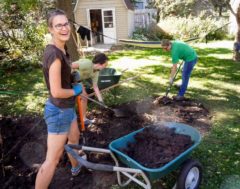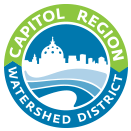What is a Minnesota Water Steward?
Minnesota Water Stewards (formerly Master Water Stewards) is a program that certifies and supports community leaders to prevent water pollution and educate community members to conserve and protect our waterways. The program is a partnership between Freshwater and participating organizations. Learn more at minnesotawaterstewards.org/
How does the program work?
The certification process comprises of both online and in-person classes covering a wide variety of topics including hydrology, water policy, community engagement, and residential stormwater planning. Classes run from mid-October to mid-April each year, with approximately six in person classes over the course of seven months.
Steward candidates are sponsored by their local water management organization or municipality and attend classes with a cohort of other candidates in their region.
Become a Minnesota Water Steward!
Interested in becoming a Minnesota Water Steward?
- The application period has closed.
- Visit minnesotawaterstewards.org/ or call us at (651) 644-8888 to learn more.
Meet 2016 Steward Amy Riegel
In spring 2019 Nat Kolasa-Lenarz, a service-learning student from the University of Minnesota spent time interviewing three of Capitol Region Watershed District’s (CRWD) Minnesota Water Stewards. We’ll be sharing the interviews to highlight the work of these community leaders, and to encourage others to consider becoming a Minnesota Water Steward.
 Amy Riegel is a 2016 Minnesota Water Steward (MWS). As part of her certification Amy educated homeowners in her neighborhood on the Adopt-A-Drain program. Amy identified that Saint Paul’s Union Park had an abundance of leaf litter collecting in streets and washing to storm drains. She led an effort to help residents understand the impact of leaf litter on water bodies and how they can help by cleaning leaves and other debris from storm drains with the Adopt-a-Drain program. Amy’s canvassing efforts led to several new Adopt-A-Drain sign-ups and increased storm drain cleanings by residents. Since completing her capstone project Amy continues to help residents install new rain gardens and maintain existing rain gardens, along with volunteering at community events.
Amy Riegel is a 2016 Minnesota Water Steward (MWS). As part of her certification Amy educated homeowners in her neighborhood on the Adopt-A-Drain program. Amy identified that Saint Paul’s Union Park had an abundance of leaf litter collecting in streets and washing to storm drains. She led an effort to help residents understand the impact of leaf litter on water bodies and how they can help by cleaning leaves and other debris from storm drains with the Adopt-a-Drain program. Amy’s canvassing efforts led to several new Adopt-A-Drain sign-ups and increased storm drain cleanings by residents. Since completing her capstone project Amy continues to help residents install new rain gardens and maintain existing rain gardens, along with volunteering at community events.
The following is an excerpt from an interview by Nat from March 2019
How long have you been a Water Steward?
Amy: I think it’s been about three years now.
Was the certification what you expected?
Amy: Yes and no. The classes and the coursework before the classes were both intensive, but the classes only lasted a short period of time. It was certainly neat to be working with a group of others from Saint Paul who were all passionate about the same things. We all kind of came from different walks of life and it was great to be immersed in that community.
Can you compare the certification process and coursework to anything as in terms of level of difficulty?
A: It’s not as difficult as a college course. Although, I was surprised at how long the coursework took me. I’d liken it more to a job training program
What surprised you about the program?
Amy: All the people I met – it was fun to meet all the different people taking the course, and not just in our watershed district. You get to meet people from across the metro area and now [MWS] they’re expanding it to include parts of the state outside the metro area, which is really exciting. I didn’t anticipate getting to connect with that many people. I also didn’t anticipate it would be such a strong network of folks. I believe this is the fourth year of Water Stewards in CRWD and they’ve been growing every year. It’s been neat to be a part of that changing community and watch it grow.
If you were to talk to someone considering the program, what would you share with them?
Amy: I would encourage anyone interested in working on water quality issues or engaging their community to pursue the program. It provides and awesome base of knowledge and it introduces you to a lot of other people, both experts and people passionate about water quality issues.
What was your greatest challenge along the way? How did you approach this challenge and what was the outcome?
Amy: I’m a renter and I was really worried about asking my neighbors about these things since I felt that as a renter, I’m kind of just passing through and I don’t really belong to a community. That’s been an ongoing challenge and I don’t know if I’ve really overcome it. I’ve lived in a few different locations as a Water Steward and it can be frustrating to feel like I don’t belong to a particular community or don’t have as much influence in that community as someone who has settled there. I have had some success with that though; I was able to install a rain garden at the house where I was living. That was a wonderful opportunity for me, and it felt good that the landlord was willing to take on the ongoing maintenance of that [water quality] practice.
One of your duties is to encourage and inspire your community to engage in water resource management projects. What have been your most effective methods?
Amy: When I was thinking about what I wanted to do for my capstone project, I initially wanted to do my project on a piece of property owned by the City of Saint Paul, but the city wasn’t willing to approve that project at that time. I persisted and continued to bring it up with the city as well as CRWD staff and that resulted in the project getting done just last summer. Persistence pays off with this kind of thing.
If you had to pick one thing that a community could do to make a difference, what would it be?
Amy: That’s a good question. I feel like the answer may sound a little funny because I would say street sweeping. I think street sweeping is under-represented and it makes a big difference in water quality. It’s so simple.
Thank you so much for your time, Amy.
